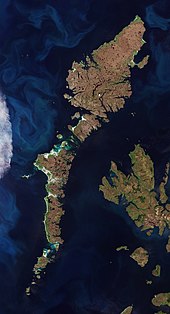

The Outer Hebrides is a chain of more than 100 islands and small skerries located about 70 kilometres (43 mi) west of mainland Scotland. There are 15 inhabited islands in this archipelago, which is also known as the Western Isles and archaically as the Long Isle (Scottish Gaelic: An t-Eilean Fada).[Note 1]
Lewis and Harris is the largest island in Scotland and the third largest in the British Isles, after Great Britain and Ireland.[2] It incorporates Lewis in the north and Harris in the south, both of which are frequently referred to as individual islands, although they are joined by a land border.[Note 2] The largest settlement in Lewis and in the Outer Hebrides is Stornoway.
To the south across the Sound of Harris lie the Uists and Benbecula, which were joined by a series of causeways constructed between 1940 and 1960 to improve transport links.[4] Further south are Barra and the smaller Barra Isles, whose southernmost extremity is Barra Head. There are other outliers with cultural links to the Outer Hebrides that are not part of the archipelago itself. These include the St Kilda group, which are quite distinct geologically and no longer inhabited,[5] Sula Sgeir and North Rona to the north and isolated Rockall, which is 367 kilometres (228 mi) to the west of North Uist.[Note 3]
The islands of Scotland's west coast are known collectively as the Hebrides and the Outer Hebrides are separated from the Inner Hebrides by The Minch to the north and the Sea of the Hebrides to the south. The Outer Hebrides are administered by Comhairle nan Eilean Siar and had a population of 26,502 in 2001.[7] The Outer Hebrides have historically been a strong Scottish Gaelic (Gàidhlig) speaking area. Despite recent declines, in the 2001 census more than 50% of the resident population in each island was able to speak Gaelic, for an overall total of 15,842 speakers throughout the archipelago.[8] The modern economy centres on tourism, crofting, fishing, and weaving, the latter of which includes the manufacture of Harris tweed. The archipelago is exposed to wind and tide, and there are numerous lighthouses as an aid to navigation.[9]
The definition of an island used in this list is that it is "land that is surrounded by seawater on a daily basis, but not necessarily at all stages of the tide, excluding human devices such as bridges and causeways".[Note 4]
- ^ Murray (1973) p. 32.
- ^ Haswell-Smith (2004) p. 262.
- ^ Thompson (1968) p. 13.
- ^ "Fleet Histories" Archived 11 July 2017 at the Wayback Machine Caledonian MacBrayne. Retrieved 3 August 2009.
- ^ Haswell-Smith (2004) pp. 313–331 lists these islands in "Section 9: The Atlantic Outliers".
- ^ Admiralty Chart NE Atlantic (1) Reykjanes Ridge & Rockall Plateau. Chart C6566. (2009) Imray, Laurie, Norie & Wilson. St Ives.
- ^ General Register Office for Scotland (2003).
- ^ Mac an Tàilleir, Iain 1901–2001 Gaelic in the Census, PowerPoint Presentation made available via Linguae Celticae[usurped]. Retrieved 1 June 2008.
- ^ "Lighthouse Library" Archived 18 September 2009 at the Wayback Machine Northern Lighthouse Board. Retrieved 14 July 2007.
Cite error: There are <ref group=Note> tags on this page, but the references will not show without a {{reflist|group=Note}} template (see the help page).